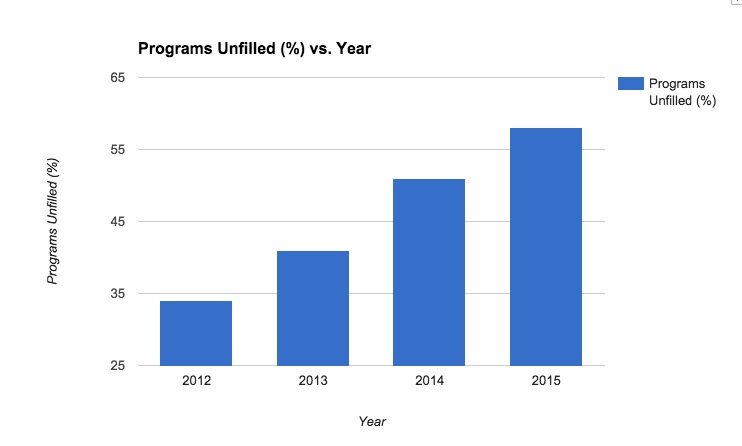An ongoing dialogue on HIV/AIDS, infectious diseases,
January 4th, 2016
A Riddle, the 2015 Clinical Trial of the Year, and a Guaranteed Laugh for All ID Doctors
Things quiet on this end recently from me due to various circumstances. but here are three ID-related (sort of) things worth sharing — enjoy if you haven’t seen them already.
Let’s start with a riddle:
- What animal is responsible for the most human deaths a year?
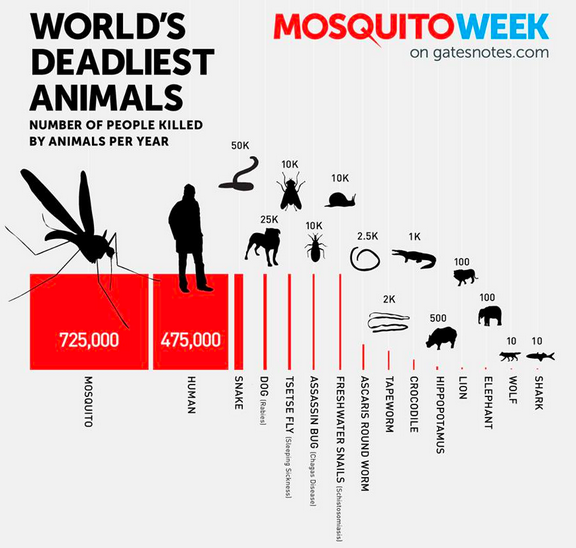
Readers of Bill Gates’ blog will think this is old news, but not everyone has seen that incredibly cool graphic. (Me, for example.)There’s zero chance I would have gotten this riddle right, even with several hours to think about it, and even with all the Zika news buzzing around (word choice intentional). Makes one think that the CRISPR projects targeting these nasty pests — so long, malaria? — are on to something, though inevitably there will be downstream consequences.
If asked, I’d have put humans first by a long shot, then maybe something like bears, which don’t even make the list, then perhaps crocodiles (still pretty scary, though not much of a threat in New England, and only one-tenth as deadly as snails). Not octupuses (which I’ve learned is the correct plural, emphatically not octupi). Or rabbits.
And who knew Gates was such a book fiend? Impressive.
- The most controversial clinical trial of 2015.
It came late in the year, so you might have missed it. From The Journal of Evaluation in Clinical Practice, here’s the full title:
Now you have no excuse. RTFA, as they say.You can imagine that this study has generated quite a bit of discussion at our family’s Journal Club, which consists of a pediatrician (my wife), an ID doctor (me), and my dog Louie, who by the graphic displayed in #1 above is the 4th most dangerous animal in the world. Easy to believe by looking at this ferocious picture.Louie was his usual taciturn self when we discussed this paper, while my wife strongly objected to the conclusion that maternal kisses don’t help cure minor boo-boos. Meanwhile, I’m wondering what kind of wound irrigation they used — low, medium, or high pressure — and whether they used prophylactic cefazolin, or vancomycin, or perhaps something that covers oral flora.
- The funniest ID-related cartoon of 2015. Nothing else even comes close.
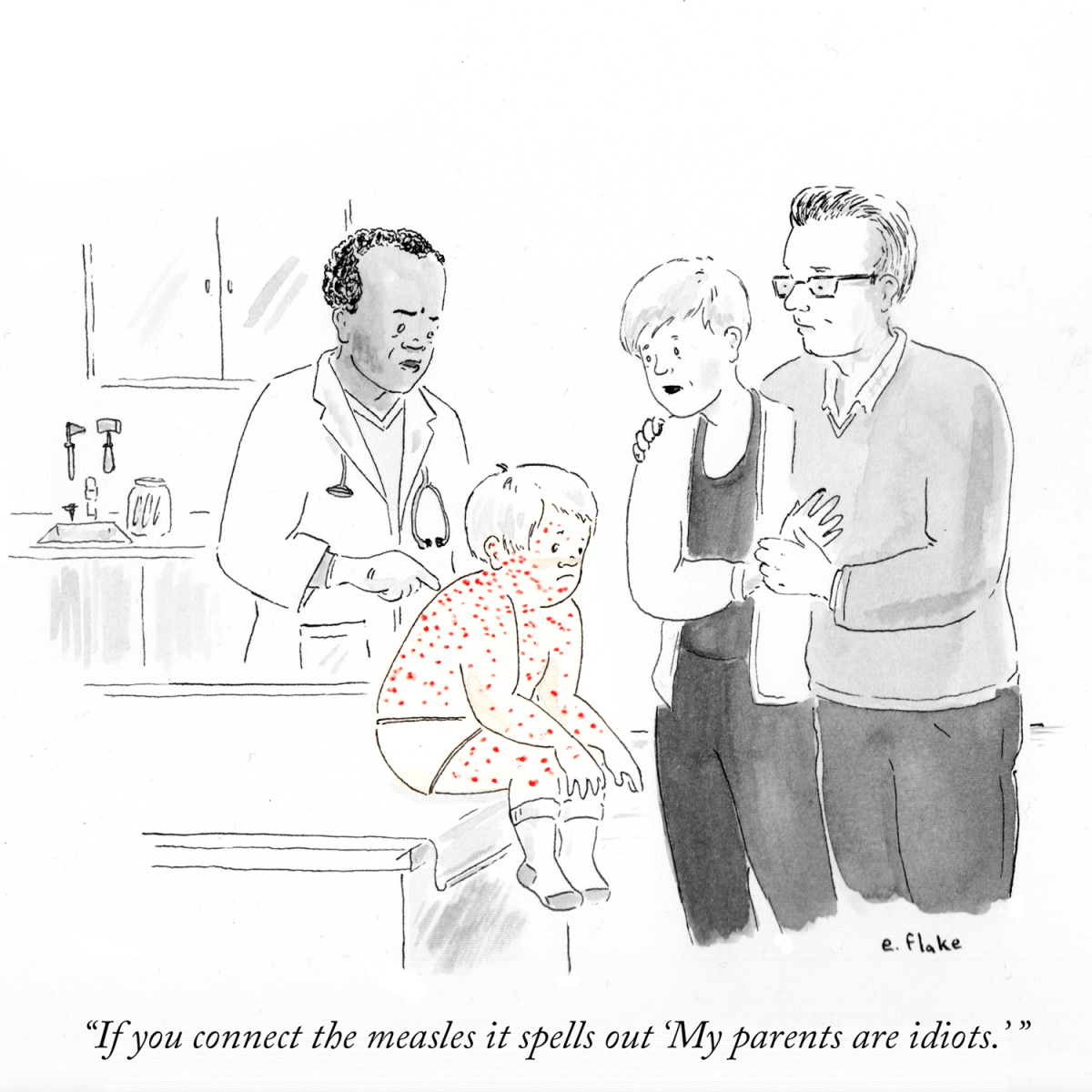
(H/T to David Paltiel for the boo-boo study.)
December 26th, 2015
A Few Things We Were Talking About On Rounds …
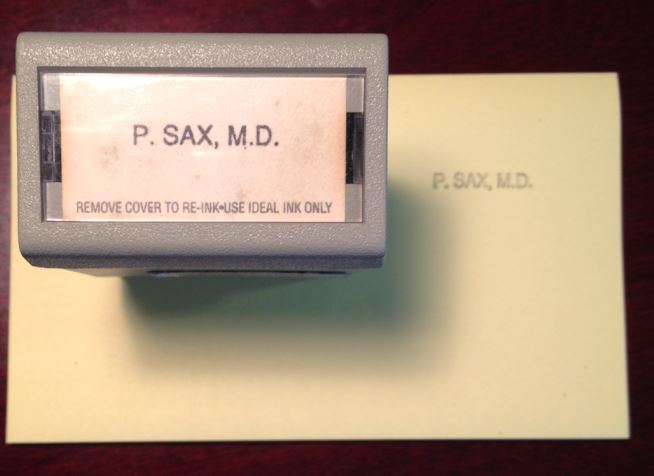 Remember when people passed out papers of interesting clinical studies and relevant reviews? And how some doctors even had a special stamp they put in the upper right hand corner?
Remember when people passed out papers of interesting clinical studies and relevant reviews? And how some doctors even had a special stamp they put in the upper right hand corner?
OK, full confession — I did that. A lot. See evidence to the right. Haven’t used the thing in well over a decade, surprised I still have it. Amazingly, it still works, though the print is getting somewhat faint.
But why did I do that? Some indirect way of getting credit for the literature search-library run-photocopying? A way of preventing reprint theft? (Never much of a crime.) Just too lazy to write out my (very short) name? I do have terrible handwriting.
Kind of ridiculous, when you think about it for a moment.
I thought of this bygone practice since I just finished some time on service, and mentioned various studies while on rounds. Passed out zero papers, for the record.
But to prove to the excellent fellow with whom I was working that the studies weren’t just made up, here are a few that came up:
- Dalbavancin is the long-acting lipoglycopeptide that is FDA-approved for skin infections , the two doses separated by a week; oritavancin is approved for just single-dose therapy. But this study of skin and soft tissue infections suggests that dalbavancin given as just one dose is just as effective as the two dose regimen. It also doesn’t require the lengthy infusion time of oritavancin — only 30 minutes for dalbavancin, 3 hours for oritavancin.
- Toxoplasmosis treatment is much in the news these days, thanks to the 5000% pyrimethamine price hike — and the always entertaining and recently arrested former CEO of the company that owns the rights to the drug. The price increase has forced many of us to adopt what most other countries (and the transplant docs) have done for years, which is to use trimethoprim-sulfamethoxazole for toxo — an antibiotic that is cheap, readily available, and can be given either IV or PO. But what’s the dose? This small randomized clinical trial used 5 mg/kg of the TMP component q12h, and found it was better tolerated and just as effective as pyrimethamine and sulfadiazine; this dose is also listed in the OI Guidelines, and it comes out to 2-3 DS tablets twice daily. Some recommend twice this dose based on other studies. Regardless, take that, Mr. Shkreli!
- Leuconostoc is not only one of the few gram positive cocci intrinsically resistant to vancomycin, it’s also not reliably sensitive to linezolid. And boy does it sound weird — a bacterium named by Russians? Who named it while working in Vladivostok? Treatment of choice is penicillin, but susceptibility testing is critical since resistance can occur. Macrolides, tetracyclines, carbapenems are also usually active. Here’s a recent case report of successful treatment with tigecycline.
 Mycobacterium gordonae is a slow-growing non-tuberculous mycobacteria that can sometimes cause clinically important infection, but is much more likely to be a colonizer or contaminant — figure to the right is proportion of pulmonary isolates that caused real disease among NTMs in the Netherlands. M gordonae is commonly found in tap water, and also is infamous for causing pseudo-outbreaks through its propensity to colonize bronchoscopes, ice machines, cleaning devices, etc.
Mycobacterium gordonae is a slow-growing non-tuberculous mycobacteria that can sometimes cause clinically important infection, but is much more likely to be a colonizer or contaminant — figure to the right is proportion of pulmonary isolates that caused real disease among NTMs in the Netherlands. M gordonae is commonly found in tap water, and also is infamous for causing pseudo-outbreaks through its propensity to colonize bronchoscopes, ice machines, cleaning devices, etc.- Penicillin-sensitive Staph aureus is on the rise! Here are the percentage of MSSA that are also penicillin-sensitive according to WHONET (H/T to Michael Calderwood):
 Our hospital has similar rates. No one (I don’t think) has any idea why this is happening — theories welcome. And we continue to be surprised by the latest endocarditis guidelines, which recommend nafcillin or oxacillin for all MSSA regardless of penicillin sensitivity — though many experts (including those who taught me) will choose penicillin if susceptibility is confirmed, since it is more active in vitro, and there is this suggestive study. The key is that the micro lab just needs to do the extra step of confirming absence of inducible beta lactamase — not difficult, and potentially clinically relevant.
Our hospital has similar rates. No one (I don’t think) has any idea why this is happening — theories welcome. And we continue to be surprised by the latest endocarditis guidelines, which recommend nafcillin or oxacillin for all MSSA regardless of penicillin sensitivity — though many experts (including those who taught me) will choose penicillin if susceptibility is confirmed, since it is more active in vitro, and there is this suggestive study. The key is that the micro lab just needs to do the extra step of confirming absence of inducible beta lactamase — not difficult, and potentially clinically relevant. - Nitrofurantoin should not be prescribed to patients with creatinine clearance < 40 due to lower efficacy and increased toxicity — accumulation of toxic nitrofurantoin-derived metabolites can occur. That means it’s not an option for the 90-year-old woman admitted with a UTI and a creatinine of 1.6 (which for the record calculates to an estimated creatinine clearance of around 20). Great recent review of nitrofurantoin here, which is particularly helpful since use of this drug has increased enormously since the change in the UTI guidelines and the rise in fluoroquinolone and TMP-SMX gram negative resistance.
Hey, hope the holidays brought you got some wonderful presents — something better than these items in the video below, which could be less useful than my stamp thing (which at least takes up almost no space in the back of my desk):
[youtube http://www.youtube.com/watch?v=FgFeVlw2Ywg]
December 19th, 2015
Part 2, Now The Good News: Why ID Will Survive as a Specialty
 Part 1 of this post, which highlighted the primary reason for declining applications to ID fellowship programs, could come across as something of a downer.
Part 1 of this post, which highlighted the primary reason for declining applications to ID fellowship programs, could come across as something of a downer.
“Moping about it won’t get us anywhere,” someone said to me, and it’s true nobody likes a whiner. But my point was to acknowledge the issue, and find a way forward. It wasn’t a whine, it was an analysis.
And I concluded with the following:
Fix the money problem, and the interest in ID will rebound nicely.
So why am still optimistic about the future of ID as a specialty? Many reasons.
Here:
- We still attract lots of the top medical residents to ID. Chief Medical Resident-types. Outstanding researchers. Residents who want to make a difference in the world. Residents who are are not motivated primarily by the money — which for ID may not be in derm-ophtho-cards-GI-radiology territory, but it’s not that bad, c’mon. Our residents who match in ID know that the best cases in the hospital and in clinic are often ID cases — where history, physical, lab findings, and therapeutics all line up for a fascinating story — and these cases are frequently featured in morning reports, CPCs, grand rounds, and other teaching venues. They also know that the research, policy, and public health opportunities in ID are almost limitless. Finally, they know about the reputation of ID doctors in the hospital and beyond. Read on.
- ID doctors are often considered the best overall clinicians out there. Ok, ok, I’m biased. But how often have you heard someone say that if they really want to know what’s going on with a complex patient, they first read the ID note? And how about this comment from Loretta S, a PCP (and one of my favorite readers): “I know the ID doc is going to have to spend countless hours reviewing the patient’s history, reviewing old labs, ordering and interpreting new labs and just generally doing deep thinking … The patients are often those for whom we in primary care are out of ideas, and we hope ID can somehow puzzle things out. And then, on top of everything, this amazing, detailed consult note comes back and I learn something new. All of which makes me, a nerd, sometimes wish I worked in ID!” Thank you Loretta. I remember during my fellowship, the Chief Resident in surgery was watching us evaluate a post-op patient with unexplained fever, and said: “Please save him, because if you guys can’t, no one can.” Thank you. (For the record, we did. It was a pulmonary embolism.)
- The field has incredible, unmatched diversity. This is a partial list of what ID has to offer: 1) “Every organ system” involved, as ID fellow applicants frequently (and accurately) point out. As a result, we see patients from every specialty, both medical and surgical — they all need us. 2) Hospital-based and outpatient-based problems, you can choose either one or both. 3) Epidemiology and public health. 4) Infection control and antibiotic stewardship. 5) The rapidly expanding world of ID diagnostics. 6) Transformative advances in therapeutics (HIV and HCV two dramatic examples, perhaps unparalleled in all of medicine). 7) The role of the microbiome, in sickness and health. 8) Infections in transplant recipients and other immunocompromised hosts. 9) Tropical and travel medicine. 10) Sexually transmitted infections. 10) Emerging infectious diseases — 10 years ago, who ever heard of Chikungunya? Or 2 years ago, Zika virus? 11) Device-related infections. 12) Tuberculosis and other mycobacterial infections. 13) Infectious complications of pregnancy. 14) Malaria and other parasitic disease. 15) ID in critical care/sepsis. 16) Immunizations and other preventive strategies … I could go on and on and on, you get the idea. In a wonderful piece about ID doctors published a few years ago, there’s this great quote from Dr. Jerome Levine, an ID doctor in New Jersey:
“Never once in all my 28 years of practice have I ever been bored,” says Levine, echoing a refrain just about universal among his colleagues.
Yes, universal!
- Care that includes ID doctors improves outcome. Maybe it’s our meticulous attention to detail. Maybe it’s our involvement with literally all the hospital services and specialties (see above). Maybe it’s because we take the best histories. Or maybe it’s just because we’re just so darned smart — there’s a minimum IQ requirement for ID
 certification of 140 — 130 won’t cut it, sorry. (If you’re so smart, why didn’t you go into Dermatology, you might be wondering. Fair enough.) Whatever the reasons, many studies have linked care by an ID specialist to better outcomes. My personal favorite is this one — title says it all: Infectious Diseases Specialty Intervention Is Associated With Decreased Mortality and Lower Healthcare Costs. Talk about a win-win situation. Is there anyone out there who, after hearing that a family member or friend were hospitalized with staph bacteremia, or fever after travel to Malaysia, or spinal osteomyelitis, or bacterial endocarditis, or meningitis/encephalitis, or infection while on rituximab, or newly diagnosed AIDS, would not want an ID doctor involved? ID consultation should be mandatory in all of these cases, for everyone’s benefit.
certification of 140 — 130 won’t cut it, sorry. (If you’re so smart, why didn’t you go into Dermatology, you might be wondering. Fair enough.) Whatever the reasons, many studies have linked care by an ID specialist to better outcomes. My personal favorite is this one — title says it all: Infectious Diseases Specialty Intervention Is Associated With Decreased Mortality and Lower Healthcare Costs. Talk about a win-win situation. Is there anyone out there who, after hearing that a family member or friend were hospitalized with staph bacteremia, or fever after travel to Malaysia, or spinal osteomyelitis, or bacterial endocarditis, or meningitis/encephalitis, or infection while on rituximab, or newly diagnosed AIDS, would not want an ID doctor involved? ID consultation should be mandatory in all of these cases, for everyone’s benefit. - Outbreak control = need for ID doctors. One of my colleagues put it perfectly after helping lead our hospital’s preparation for Ebola last year: “I always dreamed I would have to don a hazmat suit one day.” This is what he wants to do! Whether it’s norovirus infection from a fast food restaurant, listeria in cantaloupes, viral respiratory infections from camels, or Ebola virus disease in Western Africa and beyond, we are front and center in the response to every outbreak — a critical public health role locally, nationally, and internationally.
The above are all reasons — may I be so bold as to say excellent reasons? — why ID has a bright future. And included up there is what I think is an escape from the dollars mess, which is the concluding sentence in the paper cited on the association between ID care and favorable outcomes (bolding is mine):
Patients receiving ID intervention within 2 days of admission had significantly lower 30 day mortality, 30 day readmission, hospital and ICU length of stay, and Medicare charges and payments compared to patients receiving later ID interventions.
It’s up to us to demonstrate that our care improves outcomes and lowers costs, and leverage these data to improve payment for what we do. Ron Nahass, who runs one of the largest ID practices in the country, articulated several approaches in a must-read paper published last year; Eli Perencevich says we should have representation at AMA’s Relative Value Update Committee, which makes tons of sense. I hate to say this in an upcoming election year, but let the lobbying start!
ID is a dynamic, exciting field, and most of us love what we do. When asked if we’d choose our specialty again, we say “Yes!” at a rate way higher than General Internal Medicine, for those weighing a hospitalist position or primary care vs ID.
Yes, ID will survive.
Happy Holidays — and take it away, Wall of Sound!
[youtube http://www.youtube.com/watch?v=UV8x7H3DD8Y]
December 17th, 2015
A Certain Billionaire’s Arrest Prompts Universal Responses — and a Brilliantly Funny One, Too
Several words swiftly come to mind when hearing the news that Turing’s Martin Shkreli was arrested for security fraud.
- Karma.
- Just desserts.
- Kismet.
- Schadenfreude.
- Inevitable.
But leave it to Andy Borowitz to get it just right:
Ha, that’s perfect.
Diana Olson from IDSA emailed me “Someone should make a movie …”, which is of course exactly right. What a script: You have the immigrant parent upbringing, the brilliant youth getting into an elite Manhattan high school, then dropping out and starting his “work” on Wall Street at age 20. So far so good.
Then the drug-pricing scandals, his utter refusal to acknowledge wrongdoing, the all-too public face (with a very recognizable smirk) during the controversy, the ubiquitous social media presence, that Wu-Tang Clan album purchase — and now this arrest! Who knows what’s next!
Let the record show that Joel Gallant, in this OFID podcast, was asked “In 10 years, where is Martin Shkreli?” and he presciently responded:
I’d say he’s either going to be in prison or he’s doing a short sale where he’s going to make huge profits off the decline in stock prices of his company and he’ll be on a yacht in the Mediterranean somewhere.
Right now, odds favor the former.
His rise and fall story would be gold, one I’m sure Hollywood will portray with great subtlety. It would certainly have the opposite message of Woody Allen’s later movies, which exist in a random, mostly unjust universe where bad guys often seem to get away with murder. Literally.
So who plays Shkreli in the movie about his life? I vote Bill Hader from Trainwreck — check him out around 1’30” into the clip below, the likeness is truly extraordinary.
[youtube http://www.youtube.com/watch?v=2MxnhBPoIx4&w=560&h=315]
And Amy, if you still need a writer, I’m still available.
December 12th, 2015
The 2015 ID Fellowship Match “Historic Bad”: Part 1, Debating the Cause
This year’s ID fellowship match has just taken place, and the results were, ahem, not pretty. Part 1 will cover why we’re in this situation; in Part 2, I’ll offer some reasons for optimism, and even some solutions.
According to data provided by NRMP, 117 of the 335 ID fellowship positions were unfilled. Dan Diekema from U of Iowa, who has written frequently on the issue of the ID match, quickly calculated that over 80% 80 programs had at least one unfilled spot.
[That was an important edit — please see Dan’s comments below.]
When I cited this alarming figure, it generated a spirited email exchange about the ID match with Emory’s Wendy Armstrong, the source of the “historic bad” quote in the title. Wendy is also IDSA Chair of the Task Force for Recruitment to ID, so has thought a lot about this issue.
She acknowledged the trend is worrisome:
The bulk of our exchange, however, was about the reasons for this alarming trend.
Her view: It’s multifactorial: Limited ID teaching in medical school, with declining numbers of dedicated microbiology/ID courses. A significant proportion of preclinical curricula are led by microbiologists alone. ID faculty have less exposure to medical students in the hospital. There are fewer clinical electives for residents. There are fewer ID clinicians acting as attendings on medical services. It’s the money.
My view: It’s the money. At least, it’s mostly the money.
Yes, the factors listed by Wendy are part of it. But since several apply to other medical subspecialties — how many cardiologists or gastroenterologists attend on general medical services? — I’m not sure they are playing much of a role.
Why is the money issue important, and why is it particularly bad for ID? A few thoughts:
- Debt. Undergraduate medical education in this country is expensive, and a substantial number of doctors in training have significant medical school debt. They look at the 2-3 years of extra training required to become an ID specialist — followed by a lower salary — and cross ID off their list. Or at the very least, strongly consider other options if they are undecided. Or, as put succinctly here:
- The volume/procedure deficit. So long as clinicians are reimbursed primarily based on volume and procedures, ID specialists will be at a disadvantage. Medical complexity and our drive to get the details just right limit the volume part of the equation — you just can’t rush most ID consults, it would be like trying to write a guide to the Louvre after visiting for 30 minutes — and we are not trained to do procedures.
- The “lifestyle” issue. The revenue disadvantage from not doing procedures is shared with other cognitive specialists, of course, but few have so much of their work focused on hospitalized patients. Importantly, nephrology is the other major specialty with declining numbers of applicants, and I don’t think it’s a coincidence that nephrology also has plenty of hospital work. Hospital-based specialties require extensive weekend and evening call for urgent cases — cases you have to come in and see, not manage from home. Here’s a comment on my wife’s primary care listserv discussing the 2015 ID match:
ID doctors are always the ones at the hospital late at night working at our hospital. And not compensated for it they way they should be. Many are of retirement age. Only a few younger guys.
Could it be that potential applicants see ID doctors staying late in the hospital, coming in during the weekends and holidays, and wonder — why should I do that and get paid so (comparatively) poorly? The contrast with cardiology, gastroenterology, and intensivist doctors from a reimbursement perspective is obvious.
- Primary care subsidies. Primary care providers are also on the low end of the salary scale, but they rarely do extra years of training after residency. Furthermore, primary care practices may be subsidized, both explicitly through the ACA and as a way of large healthcare systems increasing the number of “covered lives”. Again, from the listserv:
I worked in HIV clinic in urban city in NJ and couldn’t believe what a new grad starts at…one did his fellowship at our hospital and was offered $85k in a private practice and the other was offered $110 as a assistant director so a lot of administrative, teaching, and research in addition to seeing patients. He had to moonlight in the prison system just to make his student loan payment!
Certainly here in Boston, and anecdotally elsewhere, PCPs start at a significantly higher salary than ID doctors.
- The rise in hospitalist positions. The winners in this race to a “real salary” in Internal Medicine? It’s the hospitalists, whose salaries generally exceed those of many ID doctors who have been in practice for years. It’s no wonder that many ID applicants today have spent at least a year after residency as a hospitalist, essentially extending their residency in terms of clinical activity, but now getting paid a whole lot more. How many of these hospitalists once considered ID training, but decided ultimately it wasn’t worth it? Longer hours for less pay, no thanks!
- Biology. In my highly unscientific poll of friends and colleagues, the period at the end of residency is the most common time for doctors to start thinking seriously about starting a family — or, in some cases, actually having babies. Such a major change certainly brings the debt, salary, and lifestyle issues cited above into stark focus.
Reading the above, you might think I’m pessimistic about the future of our speciality, but — call me crazy — in fact the opposite is true. Having one dominant cause to the problem is in many ways easier than a highly complex, multifactorial situation. Fix the money problem, and the interest in ID will rebound nicely.
In Part 2, I’ll try to justify my optimism.
Here’s a relevant 80s classic:
[youtube http://www.youtube.com/watch?v=pp4suZ4jNXg&w=420&h=315]
December 6th, 2015
Do Electronic Health Records Make You a Better (or Worse) Clinician?
Earlier this week, JAMA Internal Medicine published a study entitled, “Level of Computer Use in Clinical Encounters Associated with Patient Satisfaction”.
A more descriptive title would have been “More Computer Use in Clinical Encounters Associated with Reduced Patient Satisfaction”, as here’s the take home point:
High computer use by clinicians in safety-net clinics was associated with lower patient satisfaction and observable communication differences … Concurrent computer use may inhibit authentic engagement, and multitasking clinicians may miss openings for deeper connection with their patients.
As I’ve mentioned before (probably more times than you’d like), the computer’s power to grab our eyes away from our patients is one of the things I like least about EHRs. Of course people are less satisfied with their care when their doctor spends tons of time typing away at the keyboard and looking at the glowing screen.
(Brief aside: Some clinicians mention triangulating the encounter by having both patient and doctor review information from the EHR together. Yes you can do this sometimes, but this tactic really doesn’t work when taking a detailed history. Plus, it’s a capitulation — the computer is now the center of attention, not the patient. Finally, it’s all but impossible to pull this off in many exam rooms, especially those originally designed with no computer in mind. You’d practically have to ask your patient sit on a step-stool or hang from a trapeze over your shoulder to make this work. Not such a brief aside after all, I guess.)
I’m bringing this difficult situation up again not solely because of the published study — similar findings have been reported before. This feeling of being trapped by EHRs is not just an issue for patient satisfaction, but clinician happiness as well. One of my colleagues received a letter from her PCP, informing her that she (an experienced internist) planned to retire. It included this paragraph, which I’m sharing with that doctor’s permission:
So it’s not just the patients who don’t like it — we clinicians aren’t too thrilled either. This internist is hardly the first to complain about becoming a click-slave, though she’s the first I know to use this venue (a letter to patients) to express her opinion.
But the EHR must be good for some things, right?
Of course — a short but not all-inclusive list of the benefits could include trending of lab results, bringing up previous medication histories, displaying radiology images, reviewing other clinicians’ notes, issuing reminders about health maintenance tasks, and receiving warnings about dosing errors, allergies, and drug-drug interactions. Access to records remotely is a huge bonus.
Note I’m deliberately excluding the billing and medicolegal features, as frankly they are usually irrelevant to quality patient care. They are part of EHRs for other reasons. See here for what I think of that “functionality” (a word which always makes me cringe).
All of which makes me wonder — do EHRs make us better at what we do? Or worse?
Help please.
And just in case you missed it …
[youtube http://www.youtube.com/watch?v=xB_tSFJsjsw&w=560&h=315]
November 29th, 2015
Flu Vaccine Keeps Taking Hits, Still the Best We’ve Got — Don’t Stop “Belivin'” [sic]
For reasons understood only by the geniuses in Mountain View, CA, for some reason my Google news feed picked up this bit of “scientific” reporting: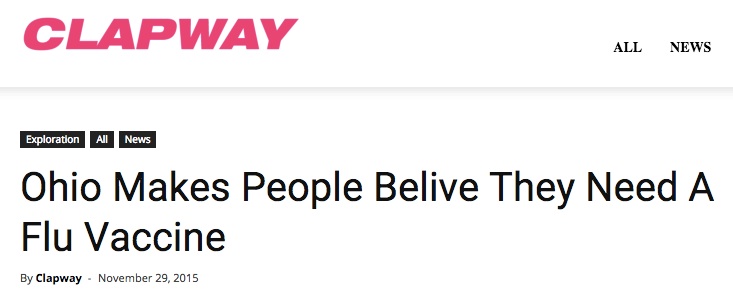
Let me allow the author, an unfortunately named “Clapway” (gonorrhea researcher?), to speak for him/herself:
However, is the flu vaccine really worth it? The author of this article never takes it and has not had the flu in years, knock on wood. There have also been various stories around the web that have stated that people who get the vaccine, immediately get the flu. It then has to be considered that the flu vaccine can be risky to take.
Is this an Onion parody? Or did Google stumble on a Junior High School science/tech blog? If so, a brief word of advice to the author — always double-check spelling (especially the title) before posting.
Admittedly, the recent news on the flu vaccine hasn’t been great — a rehash of reduced effectiveness from repeated immunizations (data are from a study published last year), how poorly the vaccine protects against H3N2, and a study suggesting that statins reduce vaccine efficacy. Of course people taking statins (cardiovascular risk, older) are exactly the people we want to get the vaccine!
On the good news front, we have yet another FDA-approved flu vaccine, this one with the wonderfully named adjuvant squalene to boost immune response. And boy does this new vaccine have a strange-looking brand name — “Fluad.” Good grief. Add it to the zillions of other flu vaccines available — just choose one!
Other good news: This year’s vaccine seems to match the circulating flu virus much better than last year. Cautious optimism.
So warts notwithstanding, until the “universal” flu vaccine is available, the current annual vaccine (in all its various permutations) is the best we’ve got. Even during last year’s dismal performance, there’s some evidence it prevented flu-related illness severe enough to cause hospitalization.
Wise words here from ID colleague Dr. Larry Madoff, who is Director of Epidemiology and Immunization at the Massachusetts Department of Public Health.
Good enough for me.
[youtube http://www.youtube.com/watch?v=VcjzHMhBtf0&w=420&h=315]
November 26th, 2015
Five (OK, Six) ID/HIV Things to be Grateful for this Holiday Season, 2015 Edition
Some quick ID/HIV gratitude items for 2015, done rapidly as we’re hosting a big meal later today.
I wonder what that might be.
- New Ebola virus disease cases and deaths have dramatically declined. I write that sentence with some trepidation, as cases continue to occur sporadically, and this late relapse in a nurse was a chilling reminder of how little we know about this disease. Additionally, since what caused the massive outbreak in Western Africa is still poorly understood, complacency about Ebola would be very ill-advised. Nonetheless, the reason we should be grateful is shown clearly in this figure of Ebola incidence:

Last year at this time we were right in the middle of that steep upward slope, with no idea when or how cases would decline. That these curves have plateaued is due to massive local control efforts (thank you!); work on both a vaccine and antiviral therapy also continue briskly. - Antibiotic prescribing declines. Whether it’s the growing awareness of the importance of the microbiome, concerns about resistance, publicity about the dreaded C diff, fear of drug toxicity, or (most likely) some combination of the above, people are receiving fewer prescriptions for antibiotics. The data from this study confirm something that most clinicians increasingly see in their patients — some sort of tipping point has been reached, where now a growing number of people are willing to tough out community-acquired respiratory infections and nagging coughs and ear aches rather than berate their doctors with references to “green phlegm” (code for “Give me a Z-pak”). Now if we can just get the farm animals to have a voice in this too — 80% of antibiotic use in this country is for agricultural purposes.
- PrEP works really, really well when given to people who want (and need) it. Confession: I thought pre-exposure prophylaxis (PrEP) for HIV was forever going to remain a very small piece of the HIV prevention effort. But I’ve been wrong (many times) before — hey, I thought putting cameras in phones was a ridiculous idea — and it turns out I was wrong about PrEP, too. In both the PROUD and IPERGAY (soon to be published in a major medical journal) studies, men who have sex with men who were at high risk of contracting HIV reduced that risk by nearly 90% by taking TDF/FTC. Not surprisingly, uptake of PrEP has increased dramatically in the past year, a trend I expect will continue given CDC’s efforts to get the word out.
- HCV treatment now works just as well in clinical practice as it does in clinical trials. Remember when combination HIV therapy came out in the mid-1990s, and several papers (notably this one) cited far worse outcomes in “real life” than in the clinical trials? Or when the same exact thing happened with telaprevir and boceprevir-containing regimens for HCV? Guess what — current HCV treatment is so good that “real life” (whatever that means) outcomes are outstanding, with cure rates greatly in excess of 90% for most genotype 1 patients. Although every HCV treater has a few examples of treatment failure, they are just that — a few.
- Treatment as prevention is staggeringly effective in preventing HIV — still. Did anyone expect zero HIV transmissions from HPTN 052 participants with virologic suppression? Or from those individuals in the cohort studies of “condomless sex”? I bet somewhere the Swiss are muttering under their breath (in French? German? Italian?), I told you so. Bottom line is that there really is all but zero risk.
- The end of the “When to Start” debate. The much-anticipated START study showed that even the healthiest HIV-infected people — those with CD4 cell counts > 500 and no symptoms — benefit from immediate antiretroviral therapy, with fewer HIV and non-HIV related serious medical problems. When you add these results to the transmission benefits in item #5 above, the clear answer to the question, “When to start?” HIV treatment is pretty straightforward. Now!
As for the video below, I’ve been waiting eagerly since my 8th grade typing class to see it in action — am very grateful finally to see it.
For the record, the dog doesn’t look so lazy to me, just patient.
Happy Thanksgiving!
November 22nd, 2015
Just Wondering: Quick ID Questions to Consider
 Several quick ID queries, some of them answerable on the Google machine — but I’m not going there. Too busy laundering my white coat!
Several quick ID queries, some of them answerable on the Google machine — but I’m not going there. Too busy laundering my white coat!
- What ever happened to amphotericin A?
- What’s the difference between a “serovar” and a “serotype”?
- Do dogs feel bad that Pasteurella multocida is more famous than Capnocytophaga canimorsus?
- Colistin resistance is bad — but how often does colistin actually work anyway?
- No one asks you to share a room with a stranger in a hotel — why do we ask sick people in hospitals to do this? Even sick people with infections?
- Why is there group A, B, C, D, F, and G, but no group E beta strep? At least I don’t think there is. Is it like Windows 9?
- Why do all the abbreviations for “integrase inhibitor” — InI, INSTI, II — sound and look so silly? Just say “integrase.”
- Why do we say trimethoprim-sulfamethoxazole with the trimethoprim part first, but the pharmacy usually writes it for our patients the opposite way?
- Don’t you think that if probiotics really prevented or helped some condition, we’d know it by now?
- Even though the name has changed, is anyone ever going to stop saying Strep bovis?
- Why are the guidelines for meningococcal immunization so complicated? Have to look them up every time.
- Why do C diff precautions start the moment we send the diagnostic test, but MRSA precautions await the results of staph susceptibility testing?
- Why was optochin never developed into an antibiotic? Is it because it doesn’t end in “-mycin” or “-cillin” or “-floxin”?
- Does anyone really know the best dosing option for strep throat?
- What proportion of doctors immediately think Aeromonas hydrophila when they hear about medicinal leeches? And what proportion who read this blog?
- Who decided it should be MRSA — and not ORSA or NRSA?
- What percentage of hospital-based ID consults recommend additional blood cultures — even when there are numerous negatives already done on that patient?
- Why did the new endocarditis guidelines advise against using penicillin for penicillin-sensitive Staph aureus? (In Boston, we call it PSSA — say it, you’ll get the joke.) In vitro, it’s the most active drug, after all.
- MALDI-TOF or MALDI-TOF MS? Seems the former should be sufficient.
- Endocarditis cases in Britain rise since they stopped using antibiotic prophylaxis for dental work — evidence that this is in fact an important preventive strategy? Or just that the British have, ahem, dental issues?
- Why do doctors always use the term “germ” in non-medical communications, but never do otherwise? And why does it mean a virus or bacteria or fungus, but never a parasite?
- When the inactivated zoster vaccine is approved, what happens to all those zoster vaccine curbside consults?
- Dogma is that you don’t need antibiotics after I and D of uncomplicated skin abscess. So why is 10 days of TMP-SMX better than 3?
- Why are certain toxic and little-used HIV drugs (ddI, d4T in particular) still on the market? Is there anyone who wouldn’t benefit from switching to something different?
- When we will stop using antibiotics to treat C diff?
- Could this white coat poll be any closer? Memories of Bush vs Gore.
Answers, opinions, speculations welcome!
Seems probiotics helped this guy (listen/watch through 1:50).
[youtube http://www.youtube.com/watch?v=3xJWxPE8G2c]
November 18th, 2015
Are There Remaining Challenges in HCV Therapy?
Prompted by (yet more) spectacular HCV study results, I posted the following questions on Twitter:
Is velpatasvir/sofosbuvir the endgame for HCV? And what will HCV researchers do now? https://t.co/vL2A9FOttR @NEJM
— Paul Sax (@PaulSaxMD) November 18, 2015
To which I got this reply from one of our very energetic second-year ID fellows:
@PaulSaxMD @NEJM what about coinfected patients, drug interactions?
— Philip Lederer (@philiplederer) November 18, 2015
OK, OK, I know what you’re wondering — don’t you two have anything better to do than fool around with a financially struggling social media platform?
Sure we do — but after years and years of “not getting” Twitter, I now (thanks to Phil) see some of the benefits, namely the rapid exchange of information and ideas, in a particularly efficient form.
But back to the topic at hand, which is the HCV regimen used in these latest studies published in the New England Journal of Medicine. All include the pan-genotypic NS5A inhibitor velpatasvir with the already-approved nucleotide sofosbuvir, given as a single pill once daily.
Results? Outstanding:
- Genotypes 1, 2, 4, 5, and 6: 99% cure.
- Genotypes 2 and 3: 99% and 95% cure, respectively.
- Decompensated cirrhosis: 86-94%.
The results really make you wonder what more we can do to make HCV treatment better. We are definitely at the flat part of the  response curve, and fortunately it has plateaued way up there, with 95% or higher cure rates for all but the sickest HCV patients, along with exceedingly rare adverse effects.
response curve, and fortunately it has plateaued way up there, with 95% or higher cure rates for all but the sickest HCV patients, along with exceedingly rare adverse effects.
So are there remaining issues? Yes, sort of — but none of them is as pressing as the obligatory elephants in the room, which are cost and access. Let’s start with Phil’s proposed challenges, plus a few others:
- Co-infected patients. Not really a problem at all — people with HIV respond just as well as those without coinfection. (Several examples of studies cited in this post.) In fact, in many ways they’ve been easier to treat, as the patients are already used to taking medications every day.
- Drug-drug interactions. Compared to what we’ve dealt with using ritonavir and cobicistat and rifampin, these are a piece of cake — unless you’re actually using ritonavir with the “PrOD” regimen. (That’s what I’ve been calling it. I never liked “3D”.)
- Cirrhosis. Especially with a history of treatment failure to interferon-based therapies. In most studies, the newer drugs don’t work quite as well in these patients — but we’re generally talking small differences. Response rates are still pretty great.
- Patients who have failed treatment with an NS5A inhibitor-containing regimen. Indeed, this does limit our options quite a bit, and assessing for resistance is anything but straightforward, especially with non genotype 1. But we’re not completely without options — alternative sofosbuvir-based regimens will work in some patients, as the resistance barrier to this particular drug is sky high. I suspect we’ll get some clarity on this issue over the next several months.
- Patients who can’t take 12 weeks of therapy. Most studies of treatment for less than 12 weeks have been disappointing. Does a shorter course mean better adherence? Lower cost? Better outcomes? Maybe. Hard to beat the current rate of cure, but still — a regimen that could be given for 2-4 weeks would be welcome for some patients. Think H pylori treatment, if you can stand the analogy, since ID doctors know squat about H pylori therapy.
- Cost. See elephants in the room, cited above. Maybe the soon-to-be-approved grazoprevir/elbasvir. We’ll see.
So what about the second part of that tweet?
And what will HCV researchers do now?
I don’t know — become experts in implementation research? Study how to cure hepatitis B? Switch to steatohepatitis? Fibrosis reversal? Learn how to juggle clubs?
[youtube http://www.youtube.com/watch?v=Ax0wl8pYk4g&w=560&h=315]


